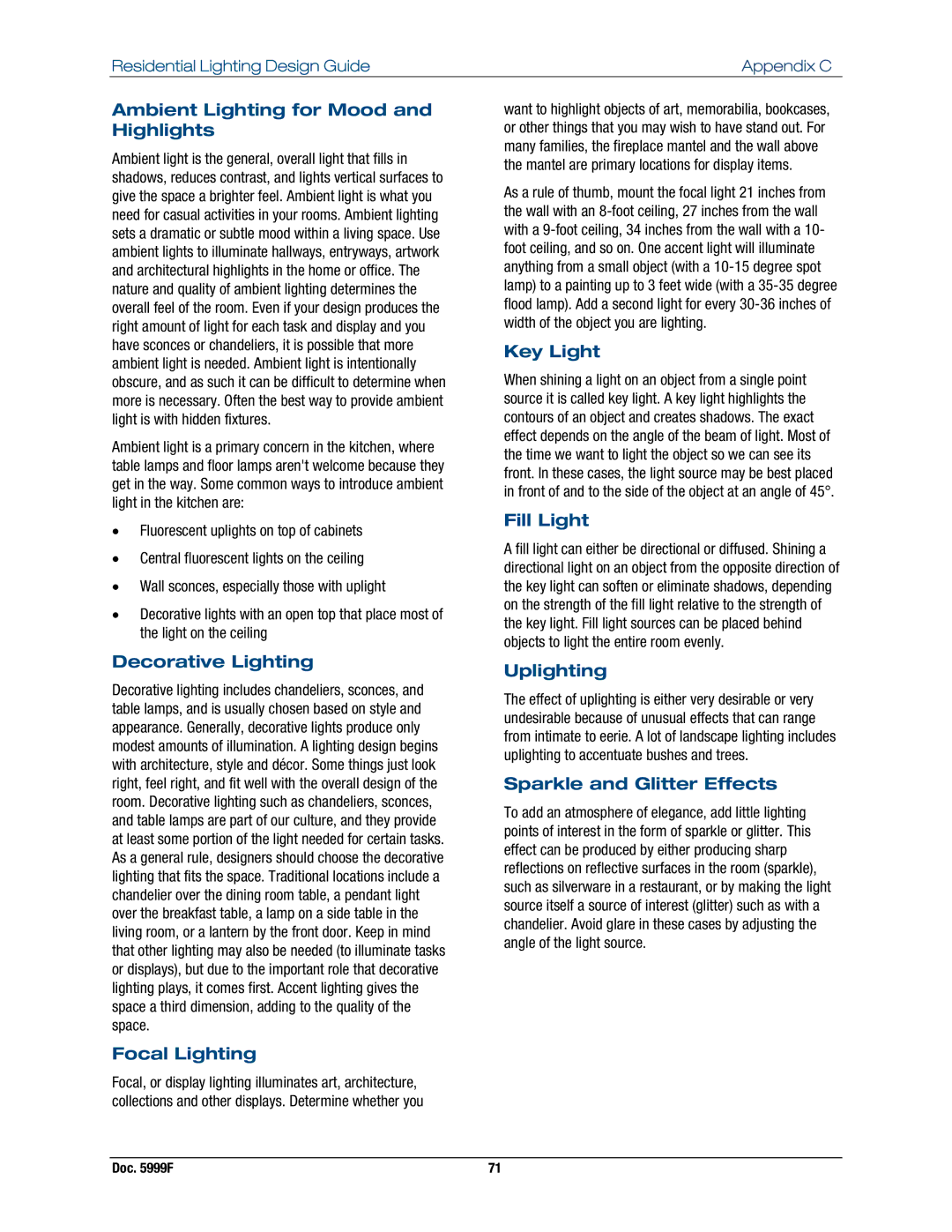Residential Lighting Design Guide | Appendix C |
Ambient Lighting for Mood and Highlights
Ambient light is the general, overall light that fills in shadows, reduces contrast, and lights vertical surfaces to give the space a brighter feel. Ambient light is what you need for casual activities in your rooms. Ambient lighting sets a dramatic or subtle mood within a living space. Use ambient lights to illuminate hallways, entryways, artwork and architectural highlights in the home or office. The nature and quality of ambient lighting determines the overall feel of the room. Even if your design produces the right amount of light for each task and display and you have sconces or chandeliers, it is possible that more ambient light is needed. Ambient light is intentionally obscure, and as such it can be difficult to determine when more is necessary. Often the best way to provide ambient light is with hidden fixtures.
Ambient light is a primary concern in the kitchen, where table lamps and floor lamps aren't welcome because they get in the way. Some common ways to introduce ambient light in the kitchen are:
∙Fluorescent uplights on top of cabinets
∙Central fluorescent lights on the ceiling
∙Wall sconces, especially those with uplight
∙Decorative lights with an open top that place most of the light on the ceiling
Decorative Lighting
Decorative lighting includes chandeliers, sconces, and table lamps, and is usually chosen based on style and appearance. Generally, decorative lights produce only modest amounts of illumination. A lighting design begins with architecture, style and décor. Some things just look right, feel right, and fit well with the overall design of the room. Decorative lighting such as chandeliers, sconces, and table lamps are part of our culture, and they provide at least some portion of the light needed for certain tasks. As a general rule, designers should choose the decorative lighting that fits the space. Traditional locations include a chandelier over the dining room table, a pendant light over the breakfast table, a lamp on a side table in the living room, or a lantern by the front door. Keep in mind that other lighting may also be needed (to illuminate tasks or displays), but due to the important role that decorative lighting plays, it comes first. Accent lighting gives the space a third dimension, adding to the quality of the space.
Focal Lighting
Focal, or display lighting illuminates art, architecture, collections and other displays. Determine whether you
want to highlight objects of art, memorabilia, bookcases, or other things that you may wish to have stand out. For many families, the fireplace mantel and the wall above the mantel are primary locations for display items.
As a rule of thumb, mount the focal light 21 inches from the wall with an
Key Light
When shining a light on an object from a single point source it is called key light. A key light highlights the contours of an object and creates shadows. The exact effect depends on the angle of the beam of light. Most of the time we want to light the object so we can see its front. In these cases, the light source may be best placed in front of and to the side of the object at an angle of 45°.
Fill Light
A fill light can either be directional or diffused. Shining a directional light on an object from the opposite direction of the key light can soften or eliminate shadows, depending on the strength of the fill light relative to the strength of the key light. Fill light sources can be placed behind objects to light the entire room evenly.
Uplighting
The effect of uplighting is either very desirable or very undesirable because of unusual effects that can range from intimate to eerie. A lot of landscape lighting includes uplighting to accentuate bushes and trees.
Sparkle and Glitter Effects
To add an atmosphere of elegance, add little lighting points of interest in the form of sparkle or glitter. This effect can be produced by either producing sharp reflections on reflective surfaces in the room (sparkle), such as silverware in a restaurant, or by making the light source itself a source of interest (glitter) such as with a chandelier. Avoid glare in these cases by adjusting the angle of the light source.
Doc. 5999F | 71 |
